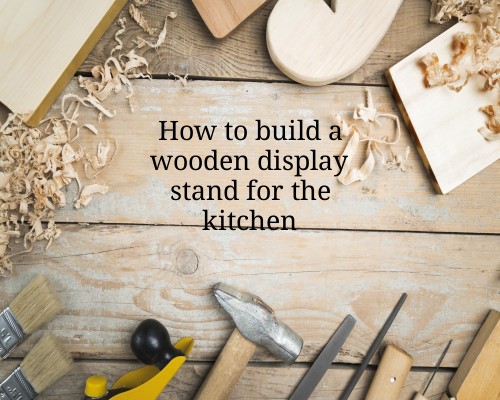Building a wooden display stand for the kitchen can be a simple and rewarding project. Here’s a step-by-step guide to help you create a functional and aesthetically pleasing display stand to showcase items like spices, cookware, or decorative elements.
Materials You Will Need:
- Wood planks (size will depend on your design)
- Pine, oak, or any hardwood of your choice
- Wood screws or nails
- Wood glue
- Sandpaper
- Paint or wood finish (optional)
- Measuring tape
- Saw (miter or circular)
- Drill
- Screwdriver or hammer
- Clamps
- Wood filler (optional)
- Level (optional)
Step 1: Plan Your Design
Before starting, decide on the type and size of the display stand. Consider factors like:
- Height: How tall will your stand be?
- Width: How wide should it be to accommodate the items you wish to display?
- Shelves: Will it be multi-tiered or a single shelf?
- Style: Modern, rustic, or minimalist?
Sketch your design with the dimensions of the space where you intend to place it (like your kitchen counter or a shelf area).
Step 2: Measure and Cut the Wood
Once you’ve decided on the design, measure the required dimensions for the vertical and horizontal parts of the display stand:
- Vertical Support: These will be the legs or side pieces that hold up the shelves.
- Shelves: These are the horizontal pieces where you’ll place your items.
Cut your wood using a saw according to the measurements. Ensure that the cuts are straight and accurate for a clean finish. Sand the edges of the cuts to remove any rough areas.
Step 3: Assemble the Frame
Start by assembling the frame of the display stand. This frame will include the legs and any cross supports for added stability.
- Apply wood glue to the edges of the vertical support pieces.
- Attach the legs to the bottom shelf (if your design is a multi-tiered stand). Use wood screws or nails to secure the pieces together.
- If your display stand has multiple levels, you can install cross supports for stability. Measure the position of the shelves and mark their locations on the vertical supports.
Step 4: Attach the Shelves
Now that the frame is built, it’s time to attach the shelves. Here’s how you can proceed:
- Position each shelf on the cross supports or directly onto the vertical supports, depending on your design.
- Use wood glue and screws to attach the shelves securely. If using screws, drill pilot holes first to prevent the wood from splitting.
- Ensure each shelf is level before securing it in place. A level tool will help ensure the shelves sit evenly.
Step 5: Sand and Finish
Once the stand is fully assembled, sand all surfaces and edges to smooth out any rough areas. Sanding will also help the paint or finish adhere better if you choose to add a coating later.
If desired, you can stain, paint, or apply a wood finish to your display stand to protect the wood and enhance its appearance. Make sure to apply the finish evenly and let it dry completely before handling.
Step 6: Install in the Kitchen
Once the display stand is assembled and finished, place it in the desired location in your kitchen. If the stand is large or heavy, consider anchoring it to the wall for added stability, especially if you plan to store heavier items on the shelves.
You can now place your kitchen items, like herbs, spices, small plants, or utensils, neatly on the display stand.
Additional Tips:
- Customization: You can add hooks or pegs along the sides for additional hanging storage.
- Wood Selection: Use wood that complements the rest of your kitchen’s decor. Lighter woods work well in modern kitchens, while darker woods suit rustic or farmhouse styles.
- Stability: If your display stand will hold heavier items, reinforce the joints with metal brackets for extra strength.
Conclusion:
Building a wooden display stand for the kitchen is an enjoyable project that can be tailored to your specific needs and style. With the right tools, materials, and a bit of patience, you can create a functional piece of furniture that will enhance your kitchen’s organization and look.
For a more in-depth woodworking guide and plans, check out Teds Woodworking Course here: Teds Woodworking Course.
